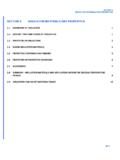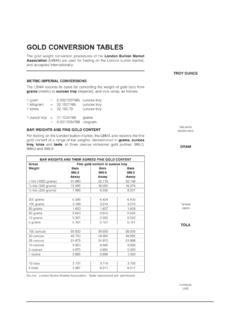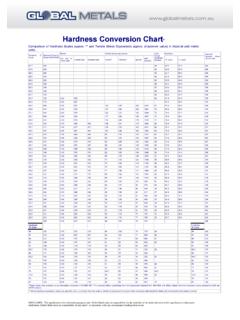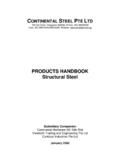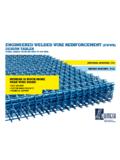Transcription of SECTION 12: DENIS FORMULA - REV #4 - IMPERIAL …
1 SECTION 12 DENIS FORMULA - REV #4 DF-8 SECTION 12: DENIS FORMULA - REV #4 - IMPERIAL OVERVIEW: DENIS FORMULA 9 STANDARD METHOD OF MEASUREMENT FOR INSTALLED INDUSTRIAL 9 CONVERSION TABLES FOR FITTINGS TO BE ADDED TO LINE TOTAL MEASURED THROUGH ALL FITTINGS 11 EXAMPLE OF PIPING MEASUREMENTS 15 SECTION 12 DENIS FORMULA - REV #4 DF-9 SECTION 12 DENIS FORMULA - REVISION #4 - IMPERIAL OVERVIEW: DENIS FORMULA James S. DENIS , President of MHG International Inc. based in Calgary, Alberta, first introduced the proposed "Standard Method of Measurement", May 1980 to a World Insulation and Acoustic Congress ( ) held in Paris, France.
2 Later in 1980, the ' DENIS FORMULA ' was introduced to major clients in the petro-chemical industry. It quickly gained approval and acceptance as 'fair' to both client and contractor. It is now widely used on industrial projects. Quite apart from the obvious benefit of having one standard method of measurement for the industry, the FORMULA , with ever increasing acceptance and usage, brings economic benefits to the owner. By identifying and defining the 'labour' intensive portions of the work, with factors to compensate for same, the FORMULA has the balancing effect of reducing 'unit prices'.
3 The prices more properly are based on the straight work where previously they had built-in difficulty factors at time of tendering. Use of the standard method of measurement ( DENIS FORMULA ) has eliminated most of the guesswork. The end result is beneficial to both the owner/client and the insulation contractor. By use of the FORMULA the parties simplify the process of determining the final quantities and value of the work with strict control over the method. STANDARD METHOD OF MEASUREMENT FOR INSTALLED INDUSTRIAL These standards are to be used for the express purpose of measuring the quantities of insulation required for a mechanical system.
4 They can be used for tendering, evaluation of bids, and for finalizing accounts. SCOPE 1. Insulation of mechanical systems including, but not limited to, vessels, equipment, exchangers, pumps, tanks, ducts or flues and pipework. 2. All measurements shall be taken on the external surface of the insulation system. 3. There shall be no deductions for surfaces not insulated within the specified insulation area. Exceptions to this rule may be negotiated where termination of insulation does not require a finish or weatherproofing and/or where the uninsulated portion is more than 5% of the total.
5 4. Irregular shapes, fittings on piping systems, valves, etc., shall be counted separately. The conversion tables of the FORMULA are designed to include for general requirements. Conversion factors for unusual items, seismological anchor or hangers, shall be negotiated by the parties prior to commencing the work. 5. All obstructions and penetrations of the insulation system shall be measured separately. 6. All effected areas and pipe lengths shall be multiplied by the complete applicable unit process. DEFINITIONS Types of insulation: hot, anti-condensation, cryogenic, acoustic, fireproofing.
6 General description of items to be insulated: SECTION 12 DENIS FORMULA - REV #4 DF-10 (a) Vessels Towers, columns, drums, containers, receivers, exchangers, storage tanks, etc. (b) Equipment Equipment which has an irregular outer surface, transitions, stiffeners, heads, roof ends, turbines, pumps, compressors, air or gas handling fans, etc. (c) Flat Surfaces Boiler walls, precipitators, hoppers, ducts & flues, storage bins, etc. (d) Piping Straight pipes, bends, elbows, accessories, fittings, valves, flanges, strainers, termination points, bevels, etc. (e) Instruments Measuring and controlling devices for process requirements.
7 (f) Height allowances Standards, see page DF-14. PRINCIPALS OF MEASURING EQUIPMENT Shell - Cylindrical The outside diameter of the vessel plus two times the insulation thickness multiplied by and by the length tangent line to tangent line as illustrated in diagram. Transition sections (changes in diameter) shall be measured using the larger diameter, times the length. There shall be no deductions for manholes and any other interruption or projection, whether insulated or not. Irregular Surfaces Any irregular shape shall be measured on the outside of the insulation surface, using the largest diameter.
8 The surface area for irregular surfaces to be multiplied by a correction factor of to obtain the equivalent area of flat surface. For small pumps, turbines, etc. the minimum equivalent area of measurement shall be 10 sq. Heads, Roofs, Ends Flat: The surface area with diameter outside of the vessel insulation. Spherical: The surface area of the hemisphere with diameter outside of the vessel insulation. Dished: The surface area of a flat circle with a diameter outside of the vessel insulation, multiplied by a correction factor of Cones: The geometrical surface area of the cone, measured outside the insulation thickness.
9 ADDITIONAL MEASUREMENTS On "Unit Price" contracts, all insulated nozzles and man-ways connecting to a vessel will be measured as pipe run to the vessel wall plus flange. In addition, all nozzles, man-ways, brackets, platform supports, obstructions, and SECTION 12 DENIS FORMULA - REV #4 DF-11 penetrations, shall have their perimeter measured as irregular surface. All penetrations shall be a minimum 1 sq. foot per each. On "Lump Sum" contracts, where like obstructions, penetrations, nozzles, brackets, supports, stiffener rings, etc. have not been shown in detail on bid drawings, they shall be measured, as above, as extra work to the contract.
10 PRINCIPALS OF MEASURING Piping Pipe shall be measured from center line to center line through all fittings, in accordance with Diagram 'A', Page 10. All fittings will be counted and classified for multiplication by the appropriate factor listed in the "Fitting Factor Tables" Pages 5 to 8. Fittings connecting two or more different sizes of pipe shall be counted as the largest size involved. Bent Pipe: Shall be measured on the outside radius of the bend(s), Traced Piping: Insulation sized to accommodate tracer(s) shall be measured at the actual size of insulation used.
